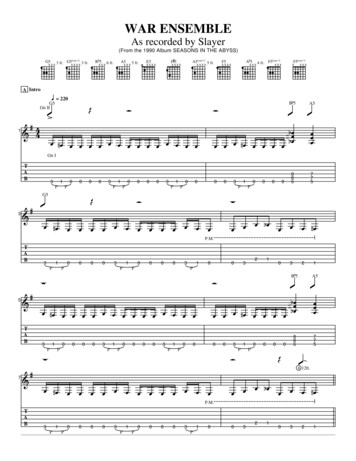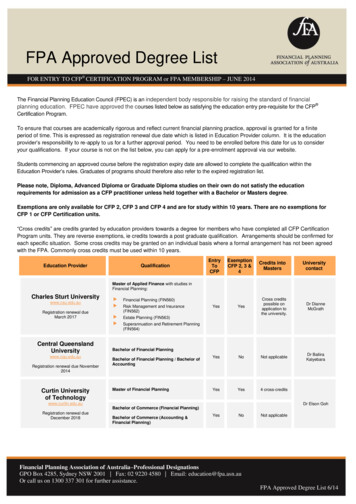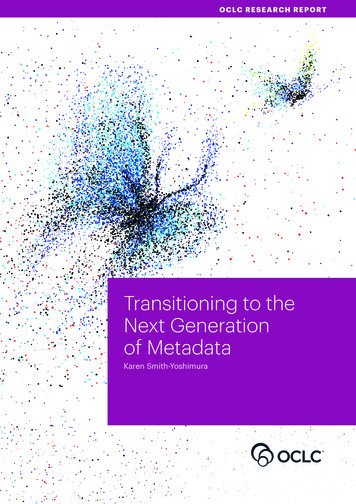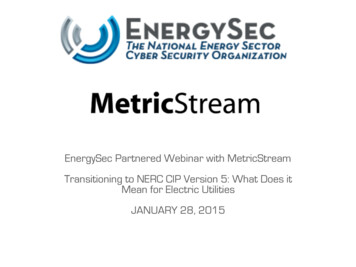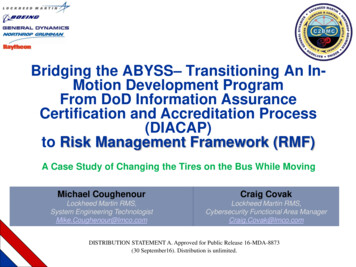
Transcription
Bridging the ABYSS– Transitioning An InMotion Development ProgramFrom DoD Information AssuranceCertification and Accreditation Process(DIACAP)to Risk Management Framework (RMF)A Case Study of Changing the Tires on the Bus While MovingMichael CoughenourCraig CovakLockheed Martin RMS,System Engineering TechnologistMike.Coughenour@lmco.comLockheed Martin RMS,Cybersecurity Functional Area ManagerCraig.Covak@lmco.comDISTRIBUTION STATEMENT A. Approved for Public Release 16-MDA-8873(30 September16). Distribution is unlimited.
Be Secure – Its Important! Building security into a system of any significantcomplexity is tough enough in today’senvironment Getting the system accredited takes a lot of workBUT Changing the rules in the middle of the game,though sometimes necessary, makes it REALLYtough!2
Take a Lifecycle Approach for Program Success What the transition looks like is directlydependent on where your program is in itslifecycle when the transition begins If transitioning pre critical design review (CDR) –can be handled like a significantrequirements/mission change Presentation & case study focus on transitionafter deployment of some of the capabilitiesThe Earlier the Better3
What it is RMF – Risk Management Framework New Accreditation (a.k.a. Authorization) constructManage security risk at acceptable levelMore complex, much more granular Case study: 18 control families » 512 controls » 1927Control Correlation Identifiers (CCIs) frame work (noun) – Basic structuresupporting a system to manage risk (security) Confidentiality, Integrity, Availability High – Medium – Low categorization for each tenet Case study: H-H-H Classified systemCompliance evaluation of all CCIs requiredfor final Authorization decision4
What it is NOT pro cess (noun) – a series of actions or steps takenin order to achieve a particular end DIACAP redefined A System Accreditation A Cyber issue RMF is a system-wide issueNecessitates involvement from all Functional Areas (FA) Ex: Dev, Net, Systems Engineering, O&M, ProgramManagement Office, Cyber A 4-letter word5
A Context – the System Development LifecycleFeasibilityStudy ponent Subsystem SystemStakeholder NeedSRRHigh LevelDesignSWDDSWDevHWDDHWDevCompInt &TestSS /ProdInt &TestSFRSysInt &TestSystemVerificationValidationOATRRPDRTrans /O&MCDRProblem SpaceValidatedSystemOCD, CONOPS, Context, MOEs,Ops ScenariosSolution SpaceSys Requirements, SysArchitecture, Sys ScenariosVerifySystem CapsIntegrateSubsystems intothe SystemSS Rqmts, Log/PhysArch, SS ScenariosIntegrateComponents intoSubsystemsComp Specs, Comp Arch,(Comp DES Pkg’s)Integrate Unitsinto ComponentsUnitBuild-ToNote: Alignment is precise from SystemDefinition Thru DevelopmentDevelop Units /AssembliesThe Product Dimension6
CASE STUDY:A LARGE MISSILE DEFENSEPROGRAM –COMMAND & CONTROL, BATTLEMANAGEMENT, ANDCOMMUNICATIONS (C2BMC)7
First Understand RMF (Dissecting It) The process wrapperControls elaborated in CCIsCustomer prioritization (critical/non-critical)Tech vs non-tech CCIs - proceed with cautionEssentially - Tech CCIs become system reqtsHave to deal with DIACAP-based sys reqts– Transform to RMF sys reqts or Create RMF baseline andretire/sunset DIACAP– Stuck between what is already done and what comes next– a look through the lifecycle*Authorization to Proceed (ATO)On the Path to ATO – Final Authorization Decision8
Joint Execution Process3ImplementationNADocument with mpliantProvide non technical/technical evidenceNon-CompliantBrief COAs for non technical /technical debtGovernment Review1.2.3.4.MDNT provides Spreadsheet for Government Review (Built incrementally and under RMF Coordination Control)Government reviews MDNT Inputs prior to MeetingQuestions answered and exceptions Resolved in MeetingUpdates with concurrence flow back through appropriate Team Working Groups and back into Spreadsheet9
To the Heart – Gems of Wisdom Early in the Transition:– Help key decision makers understand the differencebetween DIACAP and RMF early– Define Key terms helps broad-reaching decision early “organization” is critical in determining which [org] should handle theCCI (Prgm Cmd, Dev Team/Org, or Ops/sust Cmd/Team) Differentiate between “business” & “mission”– “Business” used predominately by non-DoD, “mission” by DoD Differentiate between “function” & “capability”– Capability use at acquisition level and system process level Accreditation authorization – Goes to culture: give people time tomake terminology shifts - use both to avoid confusion and lack ofunderstanding the importance of, until confident the culture hasshifted10
To the Heart – Gems of Wisdom (cont.) Early in the Transition (cont.):– Build a map to all the relevant sources / resources andmake sure all stakeholders involved in the analysis andassessment have access to them, particularly those not inpublic domain – e.g. “.mil”– Handle the level 1 (“-1”) CCIs up front (e.g. SA-1) That context effects all subsequent CCIs in the family11
To the Heart – Gems of Wisdom (cont.) Interpretation is the lynchpin – and the mostdifficult to run to ground Work on CCIs as a Group not independently(e.g. by family / enhancement)– CCIs are essentially dissections of 800-53 controlsinto atomic pieces – start in 800-53 to begin“understanding” context and intent– E.g CM-5 - The organization defines, documents, approves, andenforces physical and logical access restrictions associated withchanges to the information system became 8 CCIs12
To the Heart – Gems of Wisdom (cont.)Two particularly big challenges Develop Approach to and Get agreement thruentire Lifecycle for sell-off of CCIs/requirementsaccomplished before transition – i.e.Functionality implemented under DIACAP Culture is a powerful force – it must not beignored! It must be assessed and accounted forin the transition plan and System Engineeringapproach (see earlier NDIA presentation)13
To the Heart – Gems of Wisdom (cont.) Multiple sources need to be used simultaneouslyin analysis to understand the CCIs (e.g. 800-53,CNSSI.11, Aerospace document, Program guidance) Get approvers/assessors in-line and participatingearly– Capture assessor/customer/command decisions towardinterpretation and implementation] somewhere accessibleby all stakeholders – similar to a design decision database Ensure Government Customer and Developer arecollaborating early and frequently, constantly ifpossible14
To the Heart – Gems of Wisdom (cont.) It’s a system (holistic) challenge – it is critical that this is notmade a ‘cyber security’ challenge/responsibility – it has to bebaked-in not added on (engineered in) for Program success– have to back RMF into more than the technology during analysis andimplementation– Involve all disciplines / functional areas – anyone with skin in thegame (for each group of CCIs Economic ‘reality’ is cost and schedule constraining, so– Approach it incrementally : Option 1 – by phase (analysis, assessment, implementation) Option 2 – by priority/criticality – a group of CCIs at a time15
To the Heart – Gems of Wisdom (cont.) Implementation Gems– Define an analysis methodology with ground rules for artifacts that provide evidence toward the compliance assessment(e.g. ATO) for non-technical CCIs Walk a day-in-the-life of the assessment, with all key stakeholders,so everyone knows how to support it, where to store evidence, etc– Working with those who will evaluate compliance(Assessors) – define how evidence of compliance withCCIs will be documented, especially for non-technicalCCIs technical CCIs generally beget system requirements andsubsequently implemented in technologiccomponents/functionality that is tested and verified16
Credit where credit is due C2BMC Program MDA / BC Organization Lockheed Martin––C4USS – C4ISR & Undersea SystemsRotary and Mission Systems (RMS) Boeing team mates General Dynamic team mates Northrop Grumman team mates Raytheon team mates17
Questions and/or Comments?
-Transform to RMF sys reqts or Create RMF baseline and retire/sunset DIACAP -Stuck between what is already done and what comes next - a look through the lifecycle 8 . (Built incrementally and under RMF Coordination Control) 2. Government reviews MDNT Inputs prior to Meeting 3. Questions answered and exceptions Resolved in Meeting


